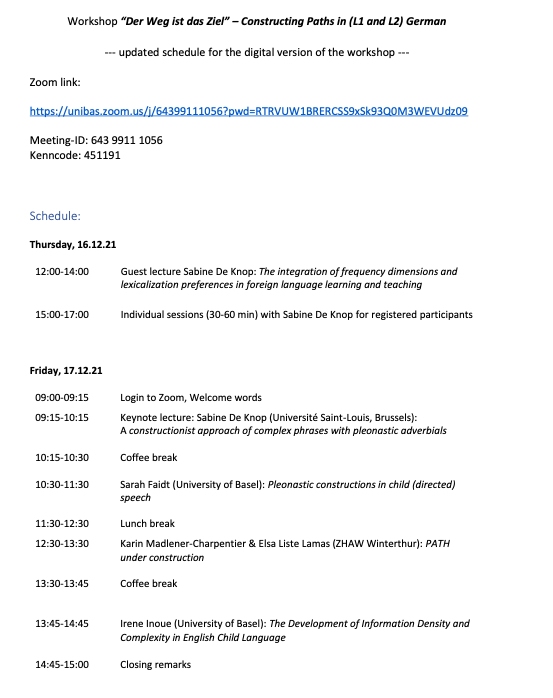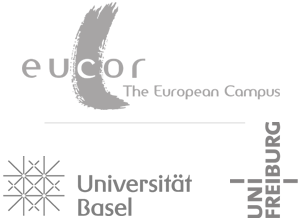Workshop: “Der Weg ist das Ziel – Constructing Paths in (L1 and L2) German”
| Contact person | Sarah Faidt |
| sarah.faidt@unibas.ch | |
| Date | Friday, 17th December 2021, 09:45 - 17:15 |
| Registration | Registration required |
| Location |
This workshop seeks to provide an opportunity to discuss and bring together current trends in the research on spatial language and language acquisition. The broad variety of spatial expressions is not only topic to insightful cross-linguistic comparisons of lexicalization patterns, but also a suitable starting point to better understand how children and language learners master cognitively and linguistically complex and pervasive concepts as found in the domain of SPACE. German as a satelliteframed language offers a wide range to verbally encode PATH information which is challenging for both L1 and L2 learners of German. The aim of this workshop is to explore the constructional inventory for expressing PATH in German from different perspectives and on the basis of different data types and methodologies: Constructional patterns for the expression of PATH shall be approached through the theoretic lens of Construction Grammar and examined in light of L1 and L2 acquisition. We will discuss empirical findings from digital language corpora, spontaneous speech data as well as from experimental data. By shedding light on lexicalization patterns in languages other than German, the scope of linguistic diversity regarding the expression of motion events shall be widened, too. In addition to input talks and project resp. paper presentations, there will be opportunities for more indebt discussions and individual consulting sessions with the keynote lecturer Prof. Sabine De Knop (Université Saint-Louis, Brussels). A tentative schedule of the workshop is provided below. Attached you will also find an abstract to the keynote talk.
Possibilities of participation:
a) All interested linguists at any stage of their research are warmly invited to participate in the workshop as an attendee and active contributor to the discussion groups. Also M.A.
students are invited to join the workshop. The maximum number of participants is limited to 20 due to the current corona virus safety measures.
In order to register to the workshop, please send an e-mail to sarah.faidt@unibas.ch until 6.12.2021.
b) Furthermore, you can register for an individual consultation with Prof. Sabine De Knop in order to address specific questions and problems within your own research concept.
Please send in a short description of your research (short background, research questions, data/method) and the precise question(s) you want to discuss with Sabine De Knop. The length of time of the individual sessions can vary, depending on the quantity and complexity of questions, between 30 and 60 minutes.
In order to register for an individual session with Sabine de Knop, please send an e-mail including the requested information on your research (as described
above) to sarah.faidt@unibas.ch until 26.11.2021.
c) As a digital “kickoff”, you are invited to attend the online guest lecture (via Zoom) by Prof. Sabine De Knop on Thursday, 16.12. 14:00-16:00, which is hosted by the M.A. lecture
Second language acquisition by Prof. Heike Behrens. The title of the guest lecture is: The integration of frequency dimensions and lexicalization preferences in foreign language learning and teaching.
Please indicate in your registration e-mail in case you wish to attend the guest lecture. A zoom link will be provided upon request.

Keynote Guest Lecture Sabine De Knop (17.12.21, 10h-11h):
The presentation deals with German pleonastic constructions (Olsen 1996) in the context of Goldberg’s (1995, 2006, 2019) Construction Grammar, as illustrated in (1)-(3).
(1) Die Mutter setzt das Kind auf das Pferd drauf.
The mother sets the child on the horse upon
‘The mother puts the child on the horse.’
(2) Mehr ist ja auch gar nicht drin in so einem Beruf.
More is yes also not at all in it in such a profession
‘That’s all there is in a job like this.’
(3) Sie laufen bis auf den Berg hinauf.
They run up to on the mountain upon
‘They run up to the mountain.’
These constructions are pleonastic, since they contain both a prepositional phrase for the expression
of motion towards a goal and a directional adverb duplicating the preposition of the prepositional phrase (compare Berthele 2004; Carroll 2000; McIntyre 2001), thereby expressing directed motion in a redundant way. In a typological perspective, these examples instantiate typical German constructions as the path of motion is preferably expressed with so-called satellites in Germanic languages (Slobin 1996 & 2017; Talmy 2000). Moreover, manner of motion is a prevalent dimension in German expressions of motion events.
With a collection of examples from the ‘Kernkorpus’ of the Digitales Wörterbuch der Deutschen Sprache (DWDS) and from DeReKo of the Institut für Deutsche Sprache (IDS) the talk focuses on the variety of pleonastic constructions and their instantiations within the framework of Construction Grammar and highlights some of the assets of this approach. The possible constituents of such form-meaning pairs are first described in detail. Pleonastic adverbials are used either in causative motion constructions (see examples (1) or (3)) or in intransitive motion or locative constructions (see (2)). The pleonastic adverbial can have an anadeictic vs. catadeictic function (Ágel 2017) in these constructions, it plays a reinforcing or specifying role, it expresses intensification (Ziem 2019). The pleonastic constructions and their instantiations are linked to each other by inheritance links and build a network of related constructions and instantiations.
